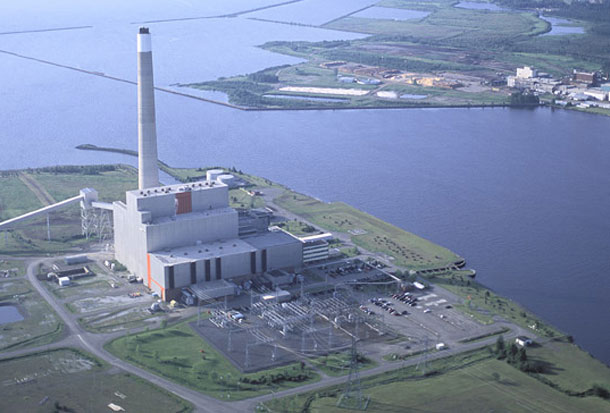THUNDER BAY – Indepth – The Energy Task Force report on the February 28th meeting with the OPA, IESO and Ministry of Energy included the following:
“The Energy Task Force requested clarification from the OPA on the public suggestion that there would be a $400 million saving by ‘mothballing’ the Thunder Bay Generating Station. The following is their explanation:
It costs $80 million per year to operate the TBGS. That is made up of the capital investment for converting it to natural gas ($100 million[1]), the annual fixed O & M costs[2] and the cost of fuel. The OPA is assuming that the converted plant would operate for 5 years until the East West Tie is operational, hence the $400 million.[3]
The Energy Task Force was unable to get the OPA to indicate what the offsetting revenue would be through the sale of the electricity over those five years. The OPA said the revenue was irrelevant to the discussion.”
At the May 3rd meeting between the same parties the question was asked again and no new information was forthcoming.
The Energy Task Force considers the cost of conversion, operation and the matching revenue key elements in the decision making process for the power needs of the Northwest. The task force also does not feel the East West tie line upgrade will be completed within the five year time frame as put forward by the OPA
BACKGROUND
A key reason for the Energy task’s analysis is, Ontario’s Green Energy Plan, which in part, has led to the regulation banning the consumption of coal for the creation of electricity.[4] As of December 31, 2014 coal can no longer fire the Atikokan and Thunder Bay Generating Stations.
The thrust of the Green Energy Plan and “Ontario’s Green Energy Act (GEA) was … to expand renewable energy generation, … and promote the creation of clean energy jobs.”
As a result the Province established key rates for the purchase of electricity from renewable forms of energy:[5][6]
Wind $120 per MWh
Solar $400 per MWh[7]
The above rates need to be compared to the other sources of power in Ontario:
In a slide presentation presented to the City of Thunder Bay by OPG it was stated that the
“Average price OPG has received is $51 per MWh.”[8]
In a separate email in response from a query from the Energy Task Force, OPG indicated that the following rates are applied to different types of generation:
Nuclear (regulated) $55 per MWh
Hydraulic (regulated) $38 per MWh (approximate)
Hydraulic (unregulated) Market price (~$30 per MWh)[9]
Thermal Coal Market price (~$30 per MWh)[10]
PRINCIPLES OF ANALYSIS
The following are the key principles used to determine the cost of converting and operating the Thunder Bay Generating Station:
- The full output of two units of the TBGS (306 MW) will be required on a full time basis to meet the identified needs[11] of the Northwest.
- The full throughput of the enhanced East-West Tieline (650 MW) will be required on a full time basis to meet the identified[12] needs of the Northwest.
- Additional energy, either through the Atikokan GS, distributed generation located within the Northwest or purchases on the spot market will be required to supplement the enhanced East West Tie and a converted and fully operational Thunder Bay GS.
- The amount paid for the energy created by the TBGS will be, at the very least, equal to the cost of generating that electricity including the conversion costs, fixed Operating and Maintenance costs and fuel.
- The projected and current loads for the Northwest are relatively stable. That is there are minimal peaks and valleys that would require much in the way of peaking supply.[13]
- Regardless of demand, the Energy Task Force is of the opinion that Thunder Bay GS is required for grid security and system reliablility in Thunder Bay and the northwestern region.
COST OF CONVERTING THUNDER BAY GS
Given the lack of costing information from the OPA, the Energy Task Force requested that the OPG provide their estimate of the cost of conversion and operation. The chart below represents the information that OPG has provided to the ETF and is reflective of the capability of the plant to generate the required electricity. It shows a breakdown of the cost estimates for various natural gas conversion scenarios for Thunder Bay GS. A 5 year value for a two unit conversion was not provided given the fact that it has not been contemplated in detail due to its unlikelihood.
These numbers are estimates, in particular the 2 unit conversion values. The OPG 5 year one-unit-on-gas number is approximately $370M vs. approximately $600M for 10 years, exclusive of the cost of fuel. The pipeline capital cost is for a pipe large enough for both units, so the pipeline cost is the same for one and two units. These figures do not include the cost of natural gas estimated to be $65 per MWh[14] from a TBGS unit.
|
TBGS Natural Gas Conversion Costs |
One Unit |
Two Units |
Two Units |
|
|
5 year |
10 year |
10 year |
20 year |
|
|
Fixed Facility Capacity Payment ($/MW-Month)[15] |
$ 29,300 |
$ 25,300 |
$ 15,500 |
|
|
Gas Delivery and Management ($/MW-Month)[16] |
$ 11,600 |
$ 8,000 |
$ 3,900 |
|
|
Subtotal annual costs ($M/yr) |
$ 74 |
$ 60 |
$ 70 |
$ 62 |
|
Total costs (5, 10 and 20 years) |
$ 368 |
$ 599 |
$ 698 |
$ 1,250 |
|
Conversion cost (included in FFCP) |
$ 59 |
$ 59 |
$ 95 |
|
The estimates for the Gas Delivery and Management component are based on a supply of gas sufficient to create 40MW of electricity. According to the OPG, this is because the OPA in its initial planning saw the Thunder Bay Generating Station as only a ‘peaking plant’ and not as a continuously operating facility. The capacity of the existing TransCanada pipeline is such that supply must be pre-ordered and there is no capacity for storage to meet on-demand requirements. Hence, additional management and storage costs must be paid for an intermittent supply. If, as the ETF has determined, the TBGS is required to run ‘full out’ the Gas Delivery and Management component will be reduced considerably, perhaps as much as 25%.
Below is a table that converts the annual operating cost of TBGS to a $/MWh for various capacity factors. These figures would be over and above the cost of the gas.
|
Price ($/MWh) to cover fixed costs |
One Unit |
Two Units |
|
|
Capacity Factor |
5 year |
10 year |
10 year |
|
25% |
224 |
182 |
106 |
|
50% |
112 |
91 |
53 |
|
75% |
75 |
61 |
35 |
With the price of natural gas estimated at $65/MWh the cost of operating the Thunder Bay GS is about $100/MWh assuming that it operates at 75% of its capacity. This rate is based on a 10 year operating period. As noted earlier, the Energy Task Force is of the opinion that the TBGS will be required for much longer than 10 years resulting in the conversion costs being spread over a much longer time frame, reducing the cost per MWh accordingly.
While this amount may appear out of reach, it is one quarter of what Ontario is currently paying for large scale solar energy and 83% of what Ontario is paying for wind power.,. The other key aspect of converting the TBGS to gas is that it would remain a dispatchable generator that would be able to quickly respond to any changing demand, including the wind not blowing and the sun not shining. Seventy Five percent capacity is above the historical rate for the Thunder Bay GS but in line with expectations of the ETF. This will result in a shortfall of 670,000 MWh of generation that will need to be secured from other sources.[17]
|
Source |
Rate per MWh |
Other Sources in Excess of TBGS on GAS (Rate/MWh) |
|
TBGS on Gas |
$100 |
0 |
|
Wind |
$120 |
$20 |
|
Solar |
$400 |
$300 |
RATE PAYER OWNED ASSET
A key component in evaluating the financial aspects of retaining the Thunder Bay GS or investing in new ways to provide the required power to the Northwest, is the existence of a rate payer owned asset in the form of the TBGS. The cost of constructing a new simple cycle gas turbine is $1.3 million per MW. Therefore the cost to construct a replacement for the TBGS with a licensed capacity of 306 MW would be $408 million. As noted previously, the full cost of conversion of the two TBGS units to natural gas is $95 million – an overall capital savings of $313 million.
COST OF OTHER SOURCES OF ENERGY
Not included in this analysis is the revenue obtained by OPG if imports through the East West Tie are from OPG assets. However, under the load envisioned by the ETF the expanded East West Tie will be needed to meet the overall needs of the region, and therefore there is no need to compare those costs to the conversion.
Also not included in this analysis is the cost of energy purchased on the spot market and imported from the west. As OPG’s average cost per MWh is relatively low compared to other sources (OPG says the average non OPG provider receives $86/MWh) it can safely be assumed that spot market prices will be above the average price received by OPG. In earlier ETF reports it has been identified that there is limited import capacities to the west. The ETF believes that it is most likely that any imports will probably be coal fired energy produce in South Dakota, purchased on the spot market, and routed through the Manitoba Energy Grid. There will be no accesses to a fixed cost price structure , for these imports, nor guaranteed available supply for the Northwest, leaving the area susceptible to an energy shortage after TBGS is closed December 31, 2014.
CONCLUSION
The Energy Task Force has determined that the conversion of the Thunder Bay Generating Station from coal to natural gas is essential if the power needs of the Northwest are to be met between now and 2020. The cost of the conversion and operation of the Thunder Bay Generating Station from coal to gas, while expensive is relatively less expensive than purchasing large volumes of energy from wind farms and large solar projects.
In addition, as the cost of converting the TBGS is less than 25% of the cost of building new generation to meet the identified needs of the Northwest it is essential that the Government of Ontario ensure that the conversion proceeds immediately.
As the conversion of the TBGS will ensure that the majority of the proposed mines can enter the production phase, Ontario will be assured that their investment in the conversion and the ongoing operation will be paid back – in spades! The combination of the direct and indirect tax revenue and the rates paid by the mine operators will ensure that Ontario will be farther ahead than if the Government fails to ensure the permanent operation of the Thunder Bay Generating Station.
Appendix A
FIT Rates
|
Date |
Solar Rates |
Wind Rates |
|||
|
5-Apr-12
|
Rooftop |
$/MWh |
Ground |
$/MWh |
$/MWh |
|
<10kW |
549 |
<10kW |
445 |
115 |
|
|
10-100kW |
548 |
10-500kW |
388 |
||
|
100-500kW |
539 |
500kW-5MW |
350 |
||
|
>500kW |
487 |
>5MW |
347 |
||
|
13-Aug-10
|
Rooftop |
$/MWh |
Ground |
$/MWh |
$/MWh |
|
<10kW |
802 |
<10kW |
642 |
135
|
|
|
10-250kW |
713 |
10kW-10MW |
443 |
||
|
250-500kW |
635 |
|
|
||
|
>500kW |
539 |
|
|
||
[1] The OPA said they got the $100 Million figure from the newspapers and attributed the source to the Energy Task Force
[2] We are advised by OPG that the annual O & M costs for the TBGS operating on natural gas are in the range of $32 to $37 Million for one or two units.
[3] It is important to note that we understand that the OPA’s estimate of $800 million was based on a single unit being operational for 5 years at a capacity of 153 MW
[4] It is important to note that Ontario did not ban other uses of coal. For example massive amounts of coal are still utilized in Ontario in the creation of steel and cement.
[5] Only large scale projects are referenced.
[6] See Appendix A for a detailed breakdown of the rates paid for renewable energy in Ontario
[7] Initially, and only for very small projects the rate was $802 per MWh.
[8] It is important to note that this average is across all forms of generation operated by OPG including thermal, nuclear and hydraulic
[9] approximate 2013 average HOEP
[10] approximate 2013 average HOEP
[11] 1579 MW as of April 30, 2013 projected through to 2020
[12] IBID
[13] The OPA has determined that Ontario’s current mining load is flat lined. Today’s pulp, paper and sawmill industry is also relatively constant in its energy requirements. The only area where there are fluctuations is in the urban service and at the most 100 MW across the entire Northwest would fluctuate.
[14] This is a longer term average estimate for energy produced at TBGS, The long term average is higher than the current price of gas.
[15] Fixed Facility Capacity Payment (FFCP) : FFCP includes OM&A costs (includes ARO, User Fee, Asset Service fee etc) sustaining project expenses and return on investment during the contracted life of project. The FFCP number represents levelized payments over the contract term.
[16] Gas Delivery & Management (GD&M) includes firm transportation, demand and balancing charges for 40 MW. It also includes contribution in aid of capital and termination charges, if any. The pipeline capital cost has increased from $ 48 M to $ 62 M since the contract with Union Gas was cancelled in November 2012, due to loss of synergy between Union Gas’ planned pipeline replacements.
[17] It is important to note that this shortfall is only related to the licensed capacity of the TBGS. An additional shortfall in available electricity must be met in order to supply all of the new mines etc that will connect to the grid between now and 2020.














